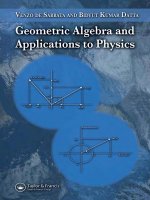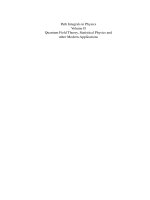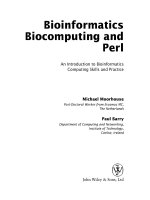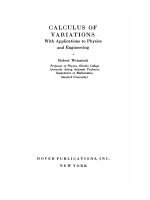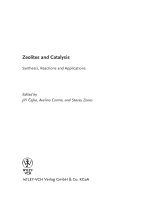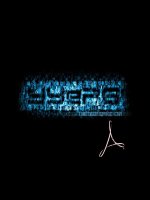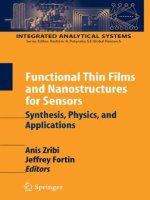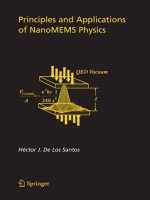- Trang chủ >>
- Khoa Học Tự Nhiên >>
- Vật lý
Kristian fossheim, asle sudboe superconductivity physics and applications wiley (2004)
Bạn đang xem bản rút gọn của tài liệu. Xem và tải ngay bản đầy đủ của tài liệu tại đây (3.92 MB, 430 trang )
Superconductivity
Physics and Applications
Kristian Fossheim and Asle Sudbø
The Norwegian University of Science and Technology
Trondheim, Norway
www.pdfgrip.com
Copyright c 2004
John Wiley & Sons Ltd, The Atrium, Southern Gate, Chichester,
West Sussex PO19 8SQ, England
Telephone (+44) 1243 779777
Email (for orders and customer service enquiries):
Visit our Home Page on www.wileyeurope.com or www.wiley.com
All Rights Reserved. No part of this publication may be reproduced, stored in a retrieval system or
transmitted in any form or by any means, electronic, mechanical, photocopying, recording, scanning or
otherwise, except under the terms of the Copyright, Designs and Patents Act 1988 or under the terms of a
licence issued by the Copyright Licensing Agency Ltd, 90 Tottenham Court Road, London W1T 4LP,
UK, without the permission in writing of the Publisher. Requests to the Publisher should be addressed to
the Permissions Department, John Wiley & Sons Ltd, The Atrium, Southern Gate, Chichester, West
Sussex PO19 8SQ, England, or emailed to , or faxed to (+44) 1243 770620.
This publication is designed to provide accurate and authoritative information in regard to the subject
matter covered. It is sold on the understanding that the Publisher is not engaged in rendering professional
services. If professional advice or other expert assistance is required, the services of a competent
professional should be sought.
Other Wiley Editorial Offices
John Wiley & Sons Inc., 111 River Street, Hoboken, NJ 07030, USA
Jossey-Bass, 989 Market Street, San Francisco, CA 94103-1741, USA
Wiley-VCH Verlag GmbH, Boschstr. 12, D-69469 Weinheim, Germany
John Wiley & Sons Australia Ltd, 33 Park Road, Milton, Queensland 4064, Australia
John Wiley & Sons (Asia) Pte Ltd, 2 Clementi Loop #02-01, Jin Xing Distripark, Singapore 129809
John Wiley & Sons Canada Ltd, 22 Worcester Road, Etobicoke, Ontario, Canada M9W 1L1
Wiley also publishes its books in a variety of electronic formats. Some content that appears
in print may not be available in electronic books.
Library of Congress Cataloging-in-Publication Data
Fossheim, K. (Kristian)
Superconductivity : physics and applications / Kristian Fossheim and Asle Sudbo.
p. cm.
Includes bibliographical references and index.
ISBN 0-470-84452-3 (alk. paper)
1. Superconductivity. I. Sudbo, Asle. II. Title.
QC611.92.F67 2004
537.6 23 – dc22
2004002271
British Library Cataloguing in Publication Data
A catalogue record for this book is available from the British Library
ISBN 0-470-84452-3
Typeset in 10.5/13pt Times by Laserwords Private Limited, Chennai, India
Printed and bound in Great Britain by Biddles Ltd, King’s Lynn
This book is printed on acid-free paper responsibly manufactured from sustainable forestry
in which at least two trees are planted for each one used for paper production.
www.pdfgrip.com
Contents
Preface
xi
Acknowledgements
I
1
BASIC TOPICS
1
What is superconductivity? A brief overview
3
1.1
1.2
1.3
1.4
1.5
1.6
1.7
2
xiii
Some introductory, historical remarks
Resistivity
The Meissner effect: perfect diamagnetism
Type I and type II superconductors
Vortex lines and flux lines
Thermodynamics of the superconducting state
Demagnetization factors and screening
3
6
10
13
17
18
23
Superconducting materials
27
2.1
2.2
27
27
27
29
31
31
34
35
35
37
37
40
41
42
2.3
2.4
2.5
2.6
Introductory remarks
Low-Tc superconductors
2.2.1 Superconducting elements
2.2.2
Binary alloys and stoichiometric compounds
Organic superconductors
2.3.1
Polymer and stacked molecular type
2.3.2
Fullerene superconductors
Chevrel phase materials
Oxide superconductors before the cuprates
High-Tc cuprate superconductors
2.6.1 The discovery of cuprate superconductors
2.6.2 Composition and structure
2.6.3 Making high Tc materials
2.6.4
Phase diagrams and doping
2.6.5 Some remarks on the original idea which led to the
discovery of cuprate superconductors
2.6.6
Thermal fluctuations of the superconducting condensate. A preliminary discussion
47
48
www.pdfgrip.com
vi
CONTENTS
2.7
2.8
2.9
3
4
52
53
55
Fermi-liquids and attractive interactions
57
3.1
3.2
3.3
3.4
57
59
61
66
66
71
75
Introduction
The non-interacting electron gas
Interacting electrons, quasiparticles and Fermi-liquids
Instability due to attractive interactions
3.4.1 Two electrons with attractive interaction
3.4.2 Phonon-mediated attractive interactions
3.4.3 Reduction of the effective Hamiltonian
The superconducting state – an electronic condensate
4.1
4.2
4.3
4.4
4.5
4.6
4.7
5
Heavy fermion superconductors
MgB2 superconductor
Summarizing remarks
BCS theory: a magnetic analogue
Derivation of the BCS gap equation
Transition temperature Tc and the energy gap
Generalized gap equation, s-wave and d-wave gaps
Quasi-particle tunnelling and the gap
4.5.1 Introductory remarks
4.5.2 The tunnelling principle
4.5.3 Single-particle NIN tunnelling
4.5.4 NIS quasiparticle tunnelling
4.5.5 SIS quasiparticle tunnelling
BCS coherence factors versus quasiparticle-effects:
ultrasound and NMR
4.6.1 Introductory remarks
4.6.2 Transition rates in ultrasound propagation and NMR
4.6.3 Longitudinal ultrasonic attenuation
4.6.4 Transverse ultrasound
4.6.5 Nuclear magnetic resonance relaxation below Tc
The Ginzburg–Landau theory
4.7.1 Some remarks on Landau theory
4.7.2 Ginzburg–Landau theory for superconductors
4.7.3 Flux quantization
79
79
81
87
89
94
94
95
97
99
102
103
103
104
105
108
113
115
115
117
121
Weak Links and Josephson Effects
123
5.1
123
123
125
128
129
131
5.2
5.3
Weak links, pair tunnelling, and Josephson effects
5.1.1 Introductory remarks
5.1.2 DC Josephson effect: the Feynman approach
AC Josephson effect
5.2.1 Alternative derivation of the AC Josephson effect
Josephson current in a magnetic field
www.pdfgrip.com
CONTENTS
5.4
5.5
5.6
5.7
5.8
6
London Approximation to Ginzburg–Landau Theory
(|ψ| constant)
6.1
6.2
6.3
6.4
6.5
6.6
6.7
7
The London equation and the penetration depth λL
6.1.1
Early electrodynamics and the London hypothesis
6.1.2 Derivation of the London equation
from the free energy
The energy of a single flux line
6.2.1 Energy of a flux line: alternative derivation.
An exercise
Interacting flux lines: the energy of an arbitrary flux
line lattice
Self energy of a single straight flux line
in the London approximation
Interaction between two parallel flux lines
Interaction between two flux lines at angle α
General flux-line lattice elastic matrix
in the London approximation
Applications of Ginzburg–Landau Theory
(|ψ| spatially varying)
7.1
7.2
7.3
7.4
7.5
7.6
7.7
8
The SQUID principle
The Ferrell–Prange equation
The critical field Hc1 of a Josephson junction
Josephson vortex dynamics
Josephson plasma in cuprate high-Tc superconductors
The temperature-dependent order parameter |ψ(T )|
The coherence length ξ
7.2.1 Relations between λ, ξ and Hc
Two types of superconductors
The structure of the vortex core
The length ξ and the upper critical field Bc2
7.5.1 Isotropic systems
7.5.2 Bc2 , ξ , and λ in anisotropic superconductors
Ginzburg–Landau–Abrikosov (GLA) predictions for Bc2 /Bc1
Surface superconductivity and Bc3
vii
134
136
138
139
140
141
141
141
146
148
151
154
160
162
164
166
171
171
172
174
175
180
182
182
184
188
190
More on the Flux-line System
199
8.1
199
199
200
201
8.2
Elementary pinning forces and simple models
8.1.1
The concept of a pinning force
8.1.2
Pinning force and flux gradient
Critical state and the Bean model
www.pdfgrip.com
viii
CONTENTS
8.3
8.4
8.5
8.6
8.7
II
9
Flux-line dynamics, thermal effects, depinning, creep
and flow
8.3.1 TAFF, flow and creep: Definitions
8.3.2 Flux flow
8.3.3 Thermally activated flux creep: Anderson model
Single particle TAFF
FLL elasticity and pinning
8.5.1 Collective effects
8.5.2 Collective creep: inverse power law U (J )
8.5.3 Logarithmic U (J )
8.5.4 The vortex solid–liquid transition
8.5.5 Lindemann criterion and melting of a clean flux-line
system
8.5.6 Modelling non-linear vortex diffusion
Flux-line entry at Bc1 : thermodynamic and geometric
restrictions
8.6.1 The critical field Bc1
8.6.2 The Bean–Livingston barrier
8.6.3 Geometric barriers
Critical current issues
8.7.1 Critical current in the Meissner state
8.7.2 Depairing critical current
8.7.3 Reduction of Jc at grain boundaries
8.7.4 Relaxation of magnetic moment
and the irreversibility line
8.7.5 How can Jc be increased?
204
204
205
206
207
208
208
212
213
215
218
224
228
228
229
232
233
233
234
235
236
242
ADVANCED TOPICS
247
Two-dimensional superconductivity. Vortex-pair unbinding
249
9.1
9.2
9.3
9.4
9.5
9.6
9.7
249
250
251
255
257
264
271
Introduction
Ginzburg–Landau description
Critical fluctuations in two-dimensional superfluids
Vortex–antivortex pairs
Mapping to the 2D Coulomb gas
Vortex-pair unbinding and Kosterlitz–Thouless transition
Jump in superfluid density
10 Dual description of the superconducting phase transition
10.1
10.2
Introduction
Lattice formulation of the Ginzburg–Landau theory
10.2.1 Lattice Ginzburg–Landau model in a frozen gauge
approximation
279
279
282
284
www.pdfgrip.com
CONTENTS
10.3
10.4
10.5
10.6
10.7
10.8
Preliminary results
Vortex-loops as topological defects of the order parameter
Superconductor–superfluid duality in d = 3
Zero-field vortex-loop blowout
10.6.1 Definitions
Fractal dimension of a vortex-loop tangle
Type I versus type II, briefly revisited
III SELECTED APPLICATIONS
ix
286
289
295
298
299
306
309
315
11 Small scale applications
11.1 More JJ-junction and SQUID basics
11.1.1 Introductory remarks
11.1.2 RSJ – the resistively shunted Josephson junction
11.1.3 Further modelling of the Josephson junction
11.1.4 The autonomous DC SQUID
11.1.5 Simplified model of the DC SQUID
11.2 SQUID applications
11.2.1 Biomagnetism: neuromagnetic applications
11.3 Superconducting electrodynamics in the two-fluid model
11.3.1 Frequency dependent conductivity
in the two fluid model
11.3.2 Surface impedance and AC loss
11.3.3 Surface resistance measurement
11.4 High-frequency radio technology
11.4.1 Microstrip filters and delay lines
11.4.2 Superconducting high-frequency devices
317
318
318
318
322
323
325
329
329
333
333
336
339
341
341
345
12 Superconducting Wire and Cable Technology
12.1 Low-Tc wire and cable
12.1.1 Introductory remarks
12.1.2 General design considerations
12.1.3 Basic superconductor properties
12.1.4 Design of technical superconductors
12.1.5 Stabilization
12.1.6 AC losses
12.1.7 Mechanical characteristics
12.1.8 Fabrication technology
12.2 High-Tc wire and cable
12.2.1 High-Tc wire and tape
12.2.2 Full-scale high-Tc cable
12.2.3 HTS induction heater
12.3 Magnet technology
349
349
349
350
350
353
355
358
359
359
362
362
363
364
366
www.pdfgrip.com
x
CONTENTS
IV TOPICAL CONTRIBUTIONS
13 Topical Contributions
13.1 Spin-Triplet superconductivity, by Y. Maeno
13.2 π -SQUIDs – realization and properties, by J. Mannhart
13.3 Doppler effect and the thermal Hall conductivity of quasiparticles in d-wave superconductors, by N.P. Ong
13.4 Nanometer-sized defects responsible for strong flux pinning in
NEG123 superconductor at 77 K, by M. Muralidhar and M.
Murakami
13.5 Hybrid Magnets, by H. Schneider-Muntau
13.6 Magneto-Optical Imaging of Vortex Matter, by T.H. Johansen
13.7 Vortices seen by scanning tunneling spectroscopy, by Oystein
Fischer
13.8 Resistivity in Vortex State in High-Tc Superconductors, by K.
Kadowaki
13.9 Coated conductors: a developing application of high temperature superconductivity, by James R. Thompson, and David K.
Christen
References Chapter 13
V
HISTORICAL NOTES
369
371
371
374
376
378
380
385
388
392
395
397
399
14 Historical notes on superconductivity: the Nobel laureates
Heike Kamerlingh Onnes
John Bardeen
Leon N. Cooper
J. Robert Schrieffer
Ivar Giaever
Brian D. Josephson
J. George Bednorz
K. Alex Măuller
Alexei A. Abrikosov
Vitaly L. Ginzburg
Pierre-Gilles de Gennes
Philip W. Anderson
401
401
402
403
404
405
407
408
410
411
413
414
415
References
417
Author index
423
Subject index
425
www.pdfgrip.com
Preface
Writing this textbook was motivated by the opinion of the authors that the
time has come for an updated look at the basics of superconductivity in the
aftermath of progress during the last couple of decades, both through the discoveries of new superconductors, and the ensuing theoretical development. High-Tc
superconductor research since 1986 represents an almost unlimited source of
information about superconductivity. This is an advantage in the sense that there
is ample material with which to fill new books, but a disadvantage in the sense
that only a very small fraction of all the efforts that were made, and the results
that came out, can be discussed here. In this sense the situation is entirely new:
The older texts, like those of de Gennes and Tinkham could discuss or refer to
almost all aspects of superconductivity of importance in the 1960s and 1970s.
With tens of thousands of papers published after 1986, there is no possibility
to take such an approach any more. We apologize to the numerous researchers
in the field whose work we could not mention. This situation leaves it even
more to the taste of the authors to choose. First and foremost we have wanted
to review the basics of superconductivity to new students in the field. Secondly,
we wanted to allow those who take a serious interest in the subject at the PhD
level, to follow the ideas to old heights like in the BCS theory, or to new heights
like in the theory of the vortex system in high-Tc cuprates. Superconductivity
is now a far richer subject thanks to the discovery of high-Tc cuprates by Bednorz and Măuller. Suddenly, superconductivity became an arena for the study
of critical behaviour in three-dimensional superconductors, an unthinkable situation in the low-Tc era. Our book seeks, among other things, to clarify this
new aspect of superconductivity. In addition, we wanted to respect the wish
of students to learn where physics meets the real life of applications. We have
concentrated the material here to the central topics, basically how to describe
and exploit the properties of Josephson junctions on the small scale, and on the
large scale to give some insight into the makings of wires and cables. A special
feature of this book is the inclusion of a chapter containing Topical Contributions from distinguished scientists in various areas of superconductivity research
and development, from the smallest to the largest scale. Each of these scientists
were invited to contribute their leading edge knowledge to give a clear idea of
www.pdfgrip.com
xii
PREFACE
the state of the art in several important sub-fields as of September 2003 when
the writing of this book came to a conclusion.
Kristian Fossheim
National High Magnetic Field Laboratory, Tallahassee,
Florida and The Norwegian University of Science
and Technology Trondheim, Norway
Asle Sudbø
The Norwegian University of Science and Technology
Trondheim, Norway
www.pdfgrip.com
Acknowledgements
From Kristian Fossheim: My part of the writing was done in about equal parts
during a sabbatical at the National High Magnetic Field Laboratory (NHMFL)
at Florida State University, in Tallahassee, Florida during the academic year
2000/2001, and upon my return to Trondheim, Norway, at the Physics Department of the Norwegian University of Science and Technology (NTNU). I greatfully acknowledge the warm hospitality of the NHMFL, and in particular Jack
Crow, Director, and Hans Schneider-Muntau, Deputy Director of the NHMFL.
I also wish to express my thanks to my wife Elsa for her patience and her
willingness to type, from day to day, my handwritten notes during our stay
in Tallahassee. I also thank the Physics Department of NTNU, Trondheim for
relieving me of some of my teaching duties during one semester of writing. In
this book we also wanted to make Nobel laureates in the field more visible to
the students, as human beings, and not just as scientific references. I therefore
visited ten laureates, videotaping interviews with them. I want to thank them
for the friendliness with which they all met me. It gave me some of the best
moments of my scientific life to meet these great scientists and fine individuals
in their own settings, and hear their own story told. In the Historical Notes,
Chapter 14 a few and brief references to these encounters are mentioned. The
rest of the material will have to be presented elsewhere. I also want to thank
Ulrik Thisted, my PhD student who undertook the task of weeding out the mistakes in my drafts, and Torbjørn Hergum for various assistance, in particular for
drawing the major part of the figures.
I dedicate this book to the memory of my parents, Nikolina and Øyvind
Fossheim.
From Asle Sudbø : I thank the Department of Physics at the California Institute
of Technology, and in particular Professor Nai-Chang Yeh, for warm hospitality
during the initial stages of this project in the autumn of 2000, which I had the
privilege of spending at CalTech on sabbatical leave. It gave me an opportunity
to try out part of the material in this textbook on some of the brightest students
one can possibly have. I also thank Professor Hagen Kleinert and the Department
of Theoretical Physics at the Freie Universităat Berlin for their hospitality during
4 months of 2001, where part of the writing was completed. I also want to thank
Dr Anh Kiet Nguyen, Dr Joakim Hove, and Dr Sjur Mo for several helpful
suggestions and for making some of the material in their PhD theses available
to me for this book. Having them as graduate students was truly a pleasure and
www.pdfgrip.com
xiv
ACKNOWLEDGEMENTS
a privilege. Finally, I want to express my sincere thanks to Professor Zlatko
Tesanovic, for the innumerable and inspiring discussions I have had with him
over the years on the physics of strongly correlated systems.
I dedicate this book to the memory of my good friend Anthony Houghton.
The authors would like to extend their special thanks to scientific colleagues
in the US, Europe and Japan for their topical contributions in Chapter 13: D. K.
Christen, Ø. Fischer, T.H. Johansen, K. Kadowaki, Y. Maeno, J. Mannhart, M.
Murakami, M. Muralidhar, N. P. Ong, H. Schneider-Muntau and J. R. Thompson.
www.pdfgrip.com
PART I
Basic Topics
Superconductivity: Physics and Applications Kristian Fossheim and Asle Sudbø
c 2004 John Wiley & Sons, Ltd ISBN 0-470-84452-3
www.pdfgrip.com
1
What is Superconductivity?
A Brief Overview
1.1 Some introductory, historical remarks
Progress in science in general, and in physics in particular, is characterized by
many great discoveries both in theory and experiment. On superficial observation these sudden advances may look like a series of accidental occurrences. But
in most cases such an impression would be wrong, in many cases even totally
misleading. Very often discoveries occur when the time is ripe, i.e. when certain
preconditions have been met, such as adequate technical capability, or attainment
of a necessary intellectual and theoretical level. The discovery of superconductivity – the property of certain conductors to display zero DC electrical
resistance – by Heike Kamerlingh Onnes and co-workers in 1911 illustrates the
point [1]. It was a true discovery, and indeed a remarkable one, because there
were no valid arguments around to predict such a phenomenon. Yet, to draw the
conclusion that it was accidental would be unjustified. The necessary technical
basis and opportunity for the discovery had been solidly established in the same
group by the liquefaction of the inert gas helium in 1908. And research, both
experimental and theoretical, on the electrical conductivity of metals at temperatures approaching the absolute zero, was ongoing and considered an important
issue by leading physicists. They were even puzzled by an apparent similarity
between the temperature dependences of electrical conductivity and heat capacity in metals. On travelling down the infinite road towards zero degrees Kelvin,
new discoveries could and should be expected, since temperature is the most
universal variable by which the (equilibrium) state of matter is defined. In fact,
the absence of discoveries along this route should have been the real surprise.
Even the cryogen itself, liquid helium, was later to offer a number of opportunities for important discovery. And many more were to come in other condensed
matter systems below ambient temperatures.
Superconductivity: Physics and Applications Kristian Fossheim and Asle Sudbø
c 2004 John Wiley & Sons, Ltd ISBN 0-470-84452-3
www.pdfgrip.com
4
WHAT IS SUPERCONDUCTIVITY?
Even the choice by Onnes of the metal to study, mercury, while appearing
perhaps surprising today, was a judicial and natural one at that time: It was the
metal that offered the most ideal conditions for the study of intrinsic properties
of metals at low temperatures due to the purity at which it could be obtained.
Purity was indeed a valid consideration, and would be even today, when studying
electrical conductivity versus temperature. Research in the Leiden laboratory
was carried out by coworkers and students of Onnes in a strictly systematic
manner. Metal upon metal was measured, and the results contemplated. Gold
was found to have almost immeasurably low resistance in the liquid helium
range; but mercury became the first substance found to be superconducting, at a
temperature near 4 K. The distinctive feature was a sudden drop of resistance by
several orders of magnitude on lowering the temperature below what appeared to
be a sharply defined temperature. Lead and tin were soon added to the list. Onnes
dismissed the prevailing idea that electrons would ‘freeze to the atom’, and
surmised instead that ‘the free electrons would remain free’ while the ‘vibrators’
(atoms) would become ‘practically immovable’1 . The timeliness of their research
is also illustrated by the fact that thermal properties were much in focus, thanks
to the blackbody problem, the early quantum theory of Planck, and the attempts
by Einstein and others to explain low-temperature heat capacity, as well as
by ongoing research on thermal and electrical conductivity of solids at lowtemperatures. The electron, a relatively recent discovery, had brought electrical
phenomena to the forefront of research. The fact that the atomic nucleus was
discovered that same year, 1911, makes this a truly remarkable year in the
history of scientific discovery.
The Leiden group attached considerable hope to the technological potential
of superconducting coils for generation of magnetic field, foreseeing fields as
high as 10 T. But they soon found an unexpected obstacle: An upper limit for
current that would flow at zero resistance in lead or tin superconductors in the
self field of the coil, what we today call the critical current Ic . This difficulty
could not be circumvented until decades later, when it was realized, first through
theoretical work, that a different kind of superconductor was needed. This new
class of superconductors was to be labeled ‘type II’ as opposed to type I for
Sn and Pb and similar conductors which had been studied in Leiden. Only
upon discovering, understanding, and further developing type II materials could
critical current density be raised to much higher, practical values. From the
1960s on a gradual development of superconductor technology has taken place,
until today when superconducting magnets are commonplace in laboratories
and hospitals all over the industrialized world. And the remarkable SQUID
technology developed for measurement of small magnetic fields, has taken on
a wide range of applications, and is showing promise in ever new fields by use
of both old and new superconductors.
1 For
an account of early work on superconductivity, see Dahl [2].
www.pdfgrip.com
SOME INTRODUCTORY, HISTORICAL REMARKS
5
Other great discoveries were to follow. The magnetic properties of superconductors attracted considerable attention through the 1920s and 1930s. A
breakthrough came in 1933 when Meissner and Ochsenfeld [3] showed that in
magnetic fields below a certain threshold value the flux inside the superconductor was expelled, and that this defined a new thermodynamic state and was
not a consequence of infinite conductivity. The phenomenon became known
as the Meissner effect, and laid the foundation for a thermodynamic treatment of superconductivity, later to be expanded when Abrikosov [4, 5] was
finally permitted to report his theory of the magnetic properties of superconductors at a meeting in Moscow in 1957. That same year Schubnikow’s [6]
important experimental work from the 1930s could also finally be recognized
publicly and posthumously in the Soviet Union. This work had already established important magnetic properties of type II superconductors two decades
earlier, and had shown promise for superconductors to carry larger current
densities than materials previously studied by Onnes, and by Meissner and
others.
1957 was also the year when the beautiful quantum theory, known as the BCS
theory, was published by Bardeen, Cooper and Schrieffer [7], finally explaining the fascinating properties of superconductors from first principles. It had
taken 46 years from the time of the discovery. A few years later Josephson’s
[8] astonishing predictions regarding the physical properties of inhomogeneous
superconductors were announced, soon followed by experimental verifications,
and by a variety of applications as well as further theoretical development.
It would take another 25 years before superconductivity made the transition
from being mainly an exotic laboratory phenomenon, known mostly to physicists, to become almost a household word. That development was to take place
by the discovery of a new class of superconductors, known as high-Tc cuprates,
by Bednorz and Măuller [9] at the IBM laboratory in Răuschlikon near Zăurich
in 1986. This is an example of a great discovery made on the basis of systematic, goal oriented research. From then on the world outside of physics became
fully aware of the almost magical properties of superconductors. The discovery
started a race towards applications that is still ongoing, with great economic
prospects. Equally intense was the desire to understand the mechanism. At the
time of writing this book, that goal has not yet been reached. In the meantime,
research has benefited greatly from the famous semi-phenomenological theories of the London brothers from the 1930s, and of Ginzburg and Landau [10]
published in 1950, in particular.
It has been estimated that well over 50 000 scientific papers have been published on superconductivity since the high-Tc discovery in 1986. A single book
can only give a modest insight into this vast amount of knowledge and results.
The present one aims to shed light on what the authors regard as the most central issues, with special emphasis on developments taken place during the last
15–20 years.
www.pdfgrip.com
6
1.2
WHAT IS SUPERCONDUCTIVITY?
Resistivity
Two fundamentally important and intuitively startling properties are associated
with superconductivity:
• The transition from finite resistivity, ρn in the normal state above a superconducting transition temperature Tc , to ρ = 0, i.e. perfect DC conductivity,
σ = ∞, below Tc .
• The simultaneous change of magnetic susceptibility χ from a small positive
paramagnetic value above Tc to χ = −1, i.e. perfect diamagnetism below Tc .
These aspects are qualitatively illustrated in Figure 1.1. Actual measurements
of resistivity as a function of temperature in a high-temperature superconducting material are shown in Figure 1.2. We shall return to the second of the
above statements in Section 1.3. Let us now discuss the implications of the first
statement.
The traditional way to measure resistance is by balancing a Wheatstone
bridge, using the sample as the fourth and unknown resistance. When balanced,
the precision of the measurement is as good as that of the resistors used in the
circuit, or possibly limited by the zero-readout accuracy of the galvanometer
used in balancing the bridge. There is a limit to how low resistance one can
claim to measure: Zero resistance is not accessible to direct measurement. By
standard methods we can measure a reduction in resistance by many orders of
magnitude, but we can never measure zero resistance in a strict sense. If we
try to measure the inverse quantity, i.e. conductivity σ = 1/ρ, the impossibility
Superconductor
r=0
0
Tc
Temperature T
Susceptibility c(T)
Resistivity r(T )
Non-superconductor
0
−1
0
Tc
Temperature T
Figure 1.1 Sketches of the two basic characteristics of a superconductor: The left figure
shows the drop to zero resistivity, ρ = 0, at a temperature Tc , compared to a nonsuperconducting behavior. The right hand figure shows the corresponding drop in susceptibility to the ideal diamagnetic value of χ = −1 below Tc . The onset of the diamagnetic
response corresponds quite closely to the point where ρ → 0 on the temperature axis. The
figure also indicates that χ is positive but quite small above Tc .
www.pdfgrip.com
RESISTIVITY
7
800
Resistance R(mΩ)
Tl-Ba-Ca-Cu-O
600
Superconducting
phase
400
Normal phase
200
r=0
0
0
100
200
300
Tc
Temperature T(K)
Figure 1.2 Experimental data on the resistance of a Tl-Ba-Ca-Cu-O ceramic sample from the
early days (1988) of high-Tc discovery (unpublished data from the Trondheim group). As was
often the case during the early days the material was not of precisely determined composition.
The value of Tc indicates that the material was close to Tl2 Ba2 Ca2 Cu3 O10 composition.
remains. No method is available to measure an infinite quantity. For the discoverers of superconductivity this was a real dilemma. Kamerlingh Onnes held on
to the belief that a ‘micro-resistance’ remained below Tc .
It is, however, still possible to arrive at the reasonable conclusion ρ → 0, or
equivalently σ → ∞, by inference from real measurements. Experiments have
been devised for this purpose. In such experiments the magnetic field associated
with an induced current has been found to remain constant during a time span
as long as 1 year. This allows an estimate to be made of the lower bound of the
decay constant, and of the upper bound of the resistance. The resulting analysis
of such a measurement leads to the conclusion that the lower bound on the
decay constant τ for the current in the superconductor is of the order of 100 000
years, implying that the total time for the current to die out completely would
be millions of years.
Let us see how such an estimate can be made. To be specific, we assume that a
current I0 is set up by induction in a superconducting closed loop at time t = 0,
at a temperature below Tc . Next, the associated magnetic field is monitored over
a very long period of time over some area in the loop, as illustrated in Figure 1.3.
As long as a resistance R exists in the superconducting loop, with inductance
L in the presence of a current I = I (t), conservation of energy requires
d
dt
with the well-known solution
1 2
LI + RI 2 = 0
2
I (t) = I0 e−(R/L)t
(1.1)
(1.2)
www.pdfgrip.com
8
WHAT IS SUPERCONDUCTIVITY?
a
B
r
I(t)
V
I
R, L
Figure 1.3 Sketch of a simple setup to monitor the possible decay of current I (t) via its
associated magnetic induction B(t) in a closed loop of inductance L and resistance R. The
wire has a diameter a and a loop radius r. The field B is normal to the loop area. The
magnetic sensor is a Hall probe.
where I0 was the initial current at time t = 0. The decay time of the current,
as well as of the corresponding magnetic induction B, is τ = L/R. Now, if
the B-field surrounding the loop is measured to be the same after a time t1 ,
say 1 year later, it appears to mean that I (t1 = 1 year) = I (t = 0) = I0 , and
similarly for the corresponding B-field. However, this statement is not an exact
one. The B-field we measure, resulting from the current I (t), can only be
measured with a certain accuracy, determined by the instruments used. If we
assume that the change of B-field can be detected with a relative instrumental
resolution δB/B0 = 10−5 , an observation of ‘no change’ in reality only sets an
upper bound on the possible decay δI of current and of field δB that may have
occurred. What the measurement can determine is therefore only the maximum
amounts by which the current I and the field B may have decayed. In reality
the decay may have been much lower. Hence we can estimate
and
δI > I0 − I (t1 ) = I 0 (1 − e−(R/L)t1 )
(1.3)
δB > B0 − B(t1 ) = B0 (1 − e−(R/L)t1 ).
(1.4)
From this it follows that
δI
δB
=
> 1 − e−(R/L)t1
I0
B0
(1.5)
Solving for R, we find its upper bound
R<−
δB
L
ln 1 −
t1
B0
=−
δI
L
ln 1 −
t1
I0
where all quantities on the right can be determined from the experiment.
(1.6)
www.pdfgrip.com
RESISTIVITY
9
If we assume that we have used a single-loop inductor with a diameter a and
loop radius r, and use the inductance formula for a single loop which applies
for r
a: L ≈ µ0 r ln(r/a), we find the expression for the upper bound on
R as
R<−
µ0 r ln(r/a)
δB
ln 1 −
t1
B0
(1.7)
Assume that we have set up the experiment with a single 5-cm radius loop of
Al wire, whose radius is 0.5 mm. If the observations went on for a year, we
have t1 ≈ 3 · 107 s. We assume as above that the instrumental resolution allows
us to measure δB/B0 = 10−5 . Using Eq. 1.7 we obtain R < 10−19 . What
resistivity ρ can we expect to observe below the superconducting transition
of Al?
Resistance and resistivity are related by R = ρ Al , where l and A are, respectively, the length and the cross section of the wire in the loop. With R < 10−19
found before, we obtain:
ρ < 10−19
A
l
≈ 2.5 × 10−25
m
(1.8)
We should therefore feel reasonably justified in treating the superconducting state
as one of zero resistivity. We have found by our estimate that the resistivity at
Tc drops by a factor of about 1013 if we take ρn in the normal state of high
purity Al to be 2.5 × 10−12 m at helium temperatures. This also tells us that
the resistivity in the superconducting state of aluminium is at least 17 orders of
magnitude lower than that of good copper at room temperature, since for copper
273K = 1.56 × 10−8
ρCu
m.
What is the lower bound on the decay time τ = L/R in the case discussed?
Using the above numbers we find τ = L/R > 5.8 × 1013 s. Because 1 year is
close to 3 × 107 s, the lower bound on the decay time is about 2 million years.
This is a factor of 10 longer than the observations referred to above, so we were
a bit generous. But we have to remember that the real observation was of no
change. The instruments are the limitation, and we may not have overestimated
the actual decay time at all. On the contrary, it might have been found to
be much longer had instruments with higher resolution been used. The quest
for an even better experimental verification of ρ = 0 in the superconducting
state could be continued. If we had used a SQUID superconducting detector
of the magnetic field (see Chapters 5 and 11), the detection limit for the small
changes in magnetic field would be lowered by several orders of magnitude
more, and the upper bound on resistance and resistivity might have been lowered
correspondingly. The lower bound on the decay time τ = L/R would then be
raised by many orders of magnitude above 1013 s that we have found so far. τ
might even approach the lifetime of the Universe. This would be in accordance
www.pdfgrip.com
10
WHAT IS SUPERCONDUCTIVITY?
with theoretical arguments in ideal situations. What better measure could we
ask for to conclude that zero resistivity is physically possible?
Having satisfied ourselves that ρ = 0 is an appropriate statement about the
electrical resistivity in a superconductor, we must immediately caution against
one particular misinterpretation: We have to keep in mind that this state of affairs
only applies to DC resistivity. An applied AC electric field accelerates charge. We
cannot avoid continually transferring energy to the electron system as long as we
keep accelerating it, i.e. as long as we expose it to an AC electric field. We shall
return to this question in detail in Chapter 11, and find that the resistance increases
with the square of the frequency, but with a very small prefactor. Consequently,
there is no abrupt change from DC to the AC resistivity in the superconducting
state as we start increasing the frequency from zero. This loss becomes important
only at very high frequencies. Still, because of the fact that in the actual technical
construction of superconducting cables, normal metals unavoidably have to be
used as part of the whole structure, there are losses, so-called coupling losses in
the normal metal surrounding the superconductor even at standard electric grid
frequencies, i.e. at 50 Hz or 60 Hz. In addition, losses caused by displacement of
supercurrent vortices in a magnetic field are important in such cases, even in DC
situations. These questions are treated in Chapters 8 and 12.
That supercurrents in ideal situations can run without observable loss for
years, indeed perhaps much more than 106 years as we found previously, is one
of Nature’s most fascinating phenomena. It contradicts all experiences we have
from physical systems in the macroscopic world, because it implies frictionless
or lossless motion of matter, in this case charged matter, which is displaced
relative to the ions. A classic analogue to electronic supercurrent transport in
an electrical circuit could be that of sliding a pebble along a flat, icy surface.
The pebble soon comes to rest because it spends all its energy working against
friction. However, in the superconducting circuit the charged particles (current)
continue to run, hence there is no friction. It is precisely because this situation is
so contrary to all our experience with other real systems that superconductivity
is such a startling and counterintuitive phenomenon.
In fact, as we shall see, superconductivity is a pure quantum physics phenomenon on a macroscopic scale. Superconductivity has an additional property
compared to the lossless motion of charged particles in atoms, namely phase
coherence of the manybody wavefunction. Indeed one of the most remarkable
feats of science was the development of a manybody quantum theory that finally
explained superconductivity, and with predictive power.
1.3
The Meissner effect: perfect diamagnetism
From the discovery of zero electrical resistivity by Onnes in 1911, 22 years
would pass until the next important discovery by Meissner and Ochsenfeld.
www.pdfgrip.com
THE MEISSNER EFFECT: PERFECT DIAMAGNETISM
11
They found that the superconducting state possesses a second characteristic,
defining property – perfect diamagnetism. Prior to this discovery there had been
considerable debate regarding the magnetic properties, and the discussion had
been based on an interpretation of the superconducting state with perfect conductivity as the (only) basic characteristic. Meissner and Ochsenfeld managed
to escape this conceptual trap by observing that a magnetic field, which was
applied above Tc would be expelled from the body of the superconductor on
cooling below Tc , leading to B = 0 inside. Using the constitutive equation for
a magnetic body we therefore have to write, in the superconducting state:
B = µ0 (H + M) = 0
(1.9)
which means that in the superconductor
M = −H.
(1.10)
Therefore, the susceptibility takes on the ideal value for a perfect diamagnet:
χ=
dM
= −1.
dH
(1.11)
Because permeability is κ = 1 + χ we also have κ = 0 below Tc . These two
ways of expressing the Meissner effect are of course equivalent, but the diamagnetic statement χ = −1 is perhaps physically more ‘descriptive’ and appealing.
What happens is that shielding currents arise in the superconductor surface.
These currents create a field both inside and outside the superconductor such
that on the inside the applied and the induced fields exactly cancel, while outside
they add. The result is that we observe expulsion of the B-field: zero B-field
inside, and an increased field near the sample, on the outside. This is illustrated in Figure 1.4. While in the normal state Faraday lines would pass straight
through the metal, practically as if there was only vacuum, in the superconducting Meissner state all lines are forced to pass on the outside. The highest
H
B≠0
c
T > Tc
0; k ≈1
NORMAL
H
Cooling
B=0
T < Tc
c = −1; k = 0
SUPERCONDUCTING
Figure 1.4 The Meissner effect in a superconductor.
www.pdfgrip.com
12
WHAT IS SUPERCONDUCTIVITY?
density of flux lines is found near the equator, while near the poles there is a
lower flux density than before the flux expulsion.
That this situation represents a thermodynamic state is demonstrated by the
experimental observation that the state is uniquely defined by the values of
the thermodynamic variables, temperature T and applied field H , independent
of how that state was reached. It is important in this context to observe that
this is not possible if perfect conductivity was the only special property that
the superconductor attained on passing below Tc . This can be confirmed by a
simple thought experiment, as in the two sequences illustrated in Figure 1.5.
Imagine (i) that a specimen which is originally at room temperature, is cooled
in zero applied field to below a temperature Tc where it acquires zero resistance,
ρ = 0. Now turn on an external magnetic field. Lenz’ law requires currents to arise
in the specimen so as to screen out the applied field. As ρ = 0 this situation will
persist forever, and no field will penetrate. Let us call this state I. Next, remove the
field. Because the prevailing requirement from Lenz’ law is to allow no change of
flux in the specimen, the currents in the sample will diminish to zero as the field
is turned off. At the end of the sequence the sample is still free of magnetic flux
inside. Call this state II. In the next sequence, (ii), start the experiment at room
temperature, this time in an applied external field. This field penetrates the sample
completely and almost totally undistorted due to the low paramagnetism of nonmagnetic metals. Now cool the specimen in the magnetic field to below the same
temperature Tc as before. Although the sample, by assumption, acquired ρ = 0 on
Cooling
(a) Ha = 0; T > Tc
(b) Ha = 0; T < Tc
(d) Ha = 0; T < Tc
(c) Ha > 0; T < Tc
Cooling
(e) Ha > 0; T > Tc
(f) Ha > 0; T < Tc
(g) Ha = 0; T < Tc
Figure 1.5 Cooling a hypothetical normal conductor with infinite conductivity in zero external field, and in a finite field, and comparing the resulting states of the material. The figure
is explained in the text, and important conclusions are drawn from that discussion.
www.pdfgrip.com
TYPE I AND TYPE II SUPERCONDUCTORS
13
passing through Tc , Lenz’ law requires the flux inside to remain perfectly constant.
Call this state III. Next, remove the external field. Again Lenz’ law requires the
flux to stay constant. This can indeed be implemented by a spontaneous current
arising on the surface. Since by assumption ρ = 0, the situation will persist forever. Call this state IV. Now compare, in particular, state II and state IV. The
thermodynamic variables T and H are the same, but the states are quite different
as just described. The difference was unavoidable due to the assumption that the
only new property that the specimen acquired on passing below Tc was perfect
conductivity. However, on exposing real superconductors to precisely the same
sequences the superconductor ends up in exactly the same state, namely one of
total flux expulsion in both cases, and again the situation is persistent. We have
two important conclusions to draw from these observations:
• Superconductivity is more than just ρ = 0.
• Superconductivity is a thermodynamic state, contrary to a state characterized
by just ρ = 0.
What happens in the Meissner effect is that spontaneous currents arise in the
surface to exactly cancel the B-field inside. Diamagnetism is well known to exist in
all matter, but usually the corresponding susceptibility is very small, typically χ =
−10−6 in atomic and molecular diamagnetism. Perfect diamagnetism clearly is a
totally different phenomenon. The reason for the large negative value is precisely
the fact that currents encompass the entire body, and are not broken up into tiny
currents circulating individual atoms. We might add that diamagnetism exists in
metals in the normal state too, due to surface currents in a magnetic field. But this
effect is more than overcome by the paramagnetism of the conduction electrons.
In the discussions of the superconducting state we have so far assumed that
currents and fields employed were below the threshold where superconductivity
breaks down. In Chapter 8 we discuss the limits as to how large currents and
fields a superconductor can tolerate before being forced to allow magnetic flux
to penetrate. As long as the superconductor is at a field below such values, and
χ = −1 is maintained, we say that the superconductor is in the Meissner state,
or Meissner phase, as shown in Figure 1.6.
These remarks point to the need of defining more precisely the thermodynamic range of superconductivity in the (H, T )-plane. This has been well
established for a great number of metals and alloys, as well as high-Tc and
other classes of superconductors. We return to this problem in the next section.
1.4 Type I and type II superconductors
Superconducting materials have the ability, as we have seen, to exist either
in the normal state or the superconducting state, depending on the external
www.pdfgrip.com
14
WHAT IS SUPERCONDUCTIVITY?
H
Hc(0)
NORMAL
Meissner phase
SUPERCONDUCTING
Tc
T
Figure 1.6 The Meissner phase of a superconductor. Under the curve, in the shaded area,
the material is perfectly screened against an external magnetic field.
magnetic field they experience. It turns out that if we increase the magnetic
field beyond a certain critical value Hc or Hc1 , which is different for different
materials, the Meissner effect breaks down. That is to say, flux penetrates into
the material. A sketch is shown in Figure 1.7. This figure shows the negative
of the magnetization along the positive vertical axis. The slope of the line
from the origin is then exactly 1 as long as the sample is in the Meissner
state, corresponding to χ = −1. Let us here first discuss the ideal case which
best brings out the underlying physics: Imagine we study a long, thin needlelike specimen, with the applied field parallel to its axis, in which case the
demagnetization factor n = 0.2 A pickup coil can be used to measure the amount
H
Type I
Type II
Magnetization – M
I
n≈0
∆I ∝ ∆M
SM
0
N
Hc
(a)
SV
SM
0
Applied field H
Hc1
N
Hc2
(b)
Figure 1.7 (a) shows the typical behaviour of a type I superconductor which switches
abruptly from the Meissner state SM to the normal state N at Hc . (b) shows a different
behaviour in a type II superconductor: At a lower critical field Hc1 the superconductor
changes state from the Meissner state with complete screening, SM , to a state of vortex
line penetration SV , and finally, at Hc2 , to the normal state N. The insert indicates that the
magnetization development can be monitored by a coil around the rod-like sample (demagnetization factor n ≈ 0) such that the change of current I is proportional to the change of
magnetization M.
2 We
refer to Section 1.7 for a discussion of demagnetization factors.
